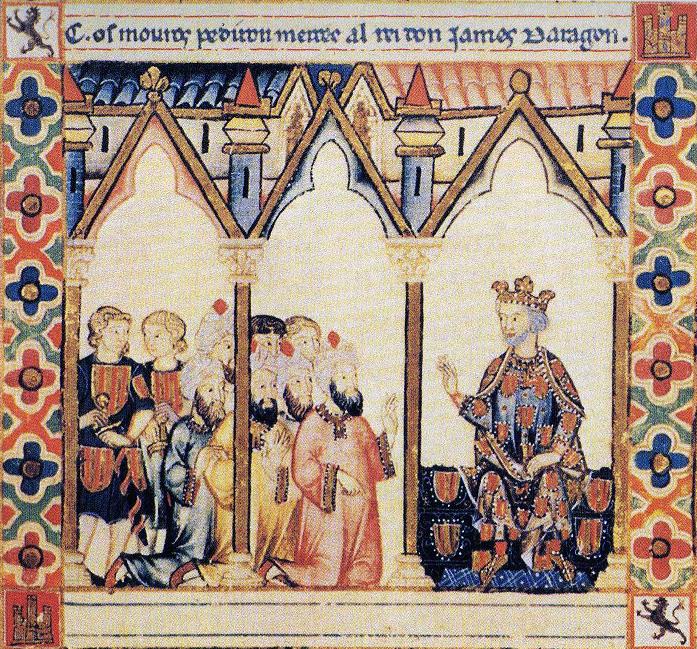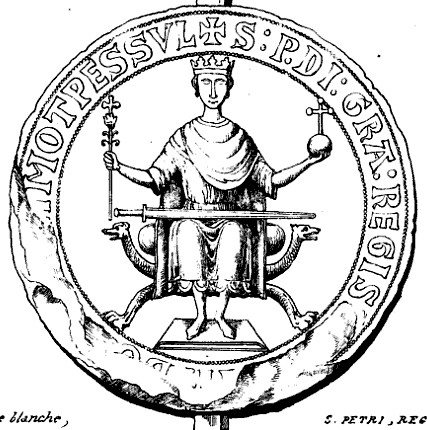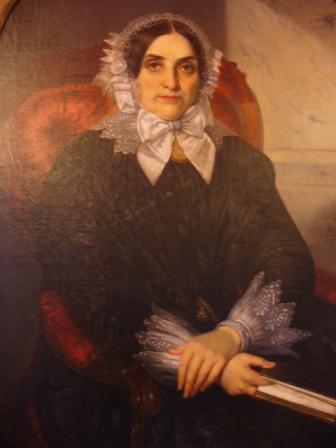|
Lordship Of Montpellier
The following is a list of lords of Montpellier: * William I of Montpellier 26 November 986–1019 * William II of Montpellier 1019–1025 * William III of Montpellier 1025–1058 * William IV of Montpellier 1058–1068 * William V of Montpellier 1090–1121 * William VI of Montpellier 1121–1149 * William VII of Montpellier 1149–c. 1172 * William VIII of Montpellier c. 1172–1202 * William IX of Montpellier 1202–1204 * Marie of Montpellier 1204–1213 ** Peter II of Aragon * James I of Aragon 1213–1276 * James II of Majorca 1276–1311 * Sancho of Majorca 1311–1324 * James III of Majorca James III ( – ), known as James the Rash (or the Unfortunate), was King of Majorca from 1324 to 1344. He was the son of Ferdinand of Majorca and Isabella of Sabran. Life James was born in Catania, Sicily. Margaret of Villehardouin, James's ... 1324–1344 In 1344 James III sold the Lordship of Montpellier to King Philip VI of France: Montpellier became a possession of ... [...More Info...] [...Related Items...] OR: [Wikipedia] [Google] [Baidu] |
Montpellier
Montpellier (, , ; oc, Montpelhièr ) is a city in southern France near the Mediterranean Sea. One of the largest urban centres in the region of Occitania (administrative region), Occitania, Montpellier is the prefecture of the Departments of France, department of Hérault. In 2018, 290,053 people lived in the city, while its Functional area (France), metropolitan area had a population of 787,705.Comparateur de territoire INSEE, retrieved 20 June 2022. The inhabitants are called Montpelliérains. In the Middle Ages, Montpellier was an important city of the Crown of Aragon (and was the birthplace of James I of Aragon, James I), and then of Kingdom of Majorca, Majorca, before its sale to France in 1349. Established in 1220, the University of Montpellier is one of the List of oldest univ ... [...More Info...] [...Related Items...] OR: [Wikipedia] [Google] [Baidu] |
Aragon Arms
Aragon ( , ; Spanish and an, Aragón ; ca, Aragó ) is an autonomous community in Spain, coextensive with the medieval Kingdom of Aragon. In northeastern Spain, the Aragonese autonomous community comprises three provinces (from north to south): Huesca, Zaragoza, and Teruel. Its capital is Zaragoza. The current Statute of Autonomy declares Aragon a '' historic nationality'' of Spain. Covering an area of , the region's terrain ranges diversely from permanent glaciers to verdant valleys, rich pasture lands and orchards, through to the arid steppe plains of the central lowlands. Aragon is home to many rivers—most notably, the river Ebro, Spain's largest river in volume, which runs west–east across the entire region through the province of Zaragoza. It is also home to the highest mountains of the Pyrenees. , the population of Aragon was , with slightly over half of it living in its capital city, Zaragoza. In 2020, the economy of Aragon generated a GDP of million, which repr ... [...More Info...] [...Related Items...] OR: [Wikipedia] [Google] [Baidu] |
Lords Of Montpellier
The following is a list of lords of Montpellier: * William I of Montpellier 26 November 986–1019 * William II of Montpellier 1019–1025 * William III of Montpellier 1025–1058 * William IV of Montpellier 1058–1068 * William V of Montpellier 1090–1121 * William VI of Montpellier 1121–1149 * William VII of Montpellier 1149–c. 1172 * William VIII of Montpellier c. 1172–1202 * William IX of Montpellier 1202–1204 * Marie of Montpellier 1204–1213 ** Peter II of Aragon * James I of Aragon 1213–1276 * James II of Majorca 1276–1311 * Sancho of Majorca 1311–1324 * James III of Majorca James III ( – ), known as James the Rash (or the Unfortunate), was King of Majorca from 1324 to 1344. He was the son of Ferdinand of Majorca and Isabella of Sabran. Life James was born in Catania, Sicily. Margaret of Villehardouin, James's ... 1324–1344 In 1344 James III sold the Lordship of Montpellier to King Philip VI of France: Montpellier became a possession of ... [...More Info...] [...Related Items...] OR: [Wikipedia] [Google] [Baidu] |
French Royal Domain
The crown lands, crown estate, royal domain or (in French) ''domaine royal'' (from demesne) of France were the lands, fiefs and rights directly possessed by the kings of France. While the term eventually came to refer to a territorial unit, the royal domain originally referred to the network of "castles, villages and estates, forests, towns, religious houses and bishoprics, and the rights of justice, tolls and taxes" effectively held by the king or under his domination. In terms of territory, before the reign of Henry IV, the ''domaine royal'' did not encompass the entirety of the territory of the kingdom of France and for much of the Middle Ages significant portions of the kingdom were the direct possessions of other feudal lords. In the tenth and eleventh centuries, the first Capetians—while being the kings of France—were among the least powerful of the great feudal lords of France in terms of territory possessed. Patiently, through the use of feudal law (and, in par ... [...More Info...] [...Related Items...] OR: [Wikipedia] [Google] [Baidu] |
Philip VI Of France
Philip VI (french: Philippe; 1293 – 22 August 1350), called the Fortunate (french: le Fortuné, link=no) or the Catholic (french: le Catholique, link=no) and of Valois, was the first king of France from the House of Valois, reigning from 1328 until his death in 1350. Philip's reign was dominated by the consequences of Succession to the French throne#The succession in 1328, a succession dispute. When Charles IV of France, King Charles IV of France died in 1328, the Proximity of blood, nearest male relative was his nephew Edward III of England, King Edward III of England, but the French nobility preferred Charles's paternal cousin Philip. At first, Edward seemed to accept Philip's succession, but he pressed English claims to the French throne, his claim to the throne of France after a series of disagreements with Philip. The result was the beginning of the Hundred Years' War in 1337. After initial successes at sea, Philip's navy was annihilated at the Battle of Sluys in 1340, e ... [...More Info...] [...Related Items...] OR: [Wikipedia] [Google] [Baidu] |
James III Of Majorca
James III ( – ), known as James the Rash (or the Unfortunate), was King of Majorca from 1324 to 1344. He was the son of Ferdinand of Majorca and Isabella of Sabran. Life James was born in Catania, Sicily. Margaret of Villehardouin, James's maternal grandmother, fought to reclaim the Principality of Achaea from the Angevins of the Kingdom of Naples. Isabella died soon after the childbirth, and James was proclaimed Prince of Achaea under the guardianship of his father. Ferdinand invaded the Morea in an effort to bring the principality under his control, but was killed in the Battle of Manolada in 1316. Despite this setback, from 1331 the feudal lords of Achaea began to recognise the rights of James, and in 1333 the recognition was total, though the Angevin heirs of Philip I of Taranto continued to press their claim. Upon the death of his uncle Sancho in 1324, James inherited the Kingdom of Majorca. His uncle Philip ruled the kingdom as regent until 1329. In order to establish ... [...More Info...] [...Related Items...] OR: [Wikipedia] [Google] [Baidu] |
Sancho Of Majorca
Sancho (; 1274 – 4 September 1324), called the Pacific or the Peaceful, was King of Majorca, Count of Roussillon and Cerdanya, and Lord of Montpellier from 1311 to his death. His 13-year-long reign was markedly undisturbed by turmoil, which earned him his epithets, and is thus often contrasted to the troublesome reigns of his father, James II, and nephew, James III, his predecessor and successor respectively. Youth Sancho was one of five children and the second son of James II and Esclaramunda of Foix. He was born in Pina, Mallorca around 1274. His father ruled the Kingdom of Majorca and adjacent fiefs under the suzerainty of his brother and afterwards nephews, the kings of Aragon. James's attempts to free himself of this vassalage led to his deposition by his nephew, King Alfonso III of Aragon, in 1286. Sancho, his mother and his elder brother, James, were taken captives by their cousin. The Queen was released but the brothers were kept in close confinement for several year ... [...More Info...] [...Related Items...] OR: [Wikipedia] [Google] [Baidu] |
James II Of Majorca
James II ( ca, Jaume) (31 May 1243 – 29 May 1311) was King of Majorca and Lord of Montpellier from 1276 until his death. He was the second son of James I of Aragon and his wife, Violant, daughter of Andrew II of Hungary. In 1279, by the Treaty of Perpignan, he became a vassal of the Crown of Aragon. Biography James inherited from his father a realm including three of the Balearic Islands (Majorca, Ibiza, and Formentera), the counties of Roussillon and Cerdanya, the dominion of Montpellier, the barony of Aumelàs, and the viscounty of Carladès. He also gained tribute from the fourth Balearic island, Menorca, which remained under Muslim control throughout his life. He ruled as a vassal of his brother Peter III of Aragon, a subordinate status which he sought to escape. In 1276, his former seneschal, Ramon Llull persuaded James to fund a language school for Franciscan missionaries at Miramar. France and Aragon contested for control of Sicily. James held rights over borderla ... [...More Info...] [...Related Items...] OR: [Wikipedia] [Google] [Baidu] |
James I Of Aragon
James I the Conqueror ( es, Jaime el Conquistador, ca, Jaume el Conqueridor; 2 February 1208 – 27 July 1276) was King of Aragon and Lord of Montpellier from 1213 to 1276; King of Majorca from 1231 to 1276; and Valencia from 1238 to 1276 and Count of Barcelona. His long reign—the longest of any Iberian monarch—saw the expansion of the Crown of Aragon in three directions: Languedoc to the north, the Balearic Islands to the southeast, and Valencia to the south. By a treaty with Louis IX of France, he achieved the renunciation of any possible claim of French suzerainty over the County of Barcelona and the other Catalan counties, while he renounced northward expansion and taking back the once Catalan territories in Occitania and vassal counties loyal to the County of Barcelona, lands that were lost by his father Peter II of Aragon in the Battle of Muret during the Albigensian Crusade and annexed by the Kingdom of France, and then decided to turn south. His great part i ... [...More Info...] [...Related Items...] OR: [Wikipedia] [Google] [Baidu] |
Peter II Of Aragon
Peter II the Catholic (; ) (July 1178 – 12 September 1213) was the King of Aragon and Count of Barcelona from 1196 to 1213. Background Peter was born in Huesca, the son of Alfonso II of Aragon and Sancha of Castile. In 1205 he acknowledged the feudal supremacy of the papacy and was crowned in Rome by Pope Innocent III, swearing to defend the Catholic faith (hence his epithet, "the Catholic"). He was the first king of Aragon to be crowned by the pope. In the first decade of the thirteenth century Peter commissioned the ''Liber feudorum Ceritaniae'', an illustrated codex cartulary for the counties of Cerdagne, Conflent, and Roussillon. Marriage On 15 June 1204 Peter married (as her third husband) Marie of Montpellier, daughter and heiress of William VIII of Montpellier by Eudocia Comnena. She gave him a son, James, but Peter soon repudiated her. Marie was popularly venerated as a saint for her piety and marital suffering, but was never canonized; she died in Rome in 1 ... [...More Info...] [...Related Items...] OR: [Wikipedia] [Google] [Baidu] |
Marie Of Montpellier
Marie of Montpellier (adapted from Occitan: Maria de Montpelhièr) (1182 – 21 April 1213) was Lady of Montpellier and by her three marriages Viscountess of Marseille, Countess of Comminges and Queen of Aragon. She was the daughter of William VIII, Lord of Montpellier, by his wife Eudokia Komnene, a niece of Byzantine Emperor Manuel I Komnenos. Life Since her birth, Marie was the legitimate heiress of the Lordship of Montpellier, because a clause of the marriage contract of her parents established that the firstborn child, boy or girl, would succeed in Montpellier on William VIII's death. In April 1187, William VIII repudiated Eudokia Komnene and married a certain Agnes, a relative of the Kings of Aragon. She bore him eight children, six sons and two daughters. Although Eudokia entered in a convent in Aniane as a Benedictine nun, William VIII's second marriage was declared invalid and all the children born from this union declared illegitimate, so Marie remained as the undi ... [...More Info...] [...Related Items...] OR: [Wikipedia] [Google] [Baidu] |
Seigneurs De Montpellier
''Seigneur'' is an originally feudal title in France before the Revolution, in New France and British North America until 1854, and in the Channel Islands to this day. A seigneur refers to the person or collective who owned a ''seigneurie'' (or ''seigneury'')—a form of land tenure—as a fief, with its associated rights over person and property. A seigneur could be an individual—male or female (''seigneuresse''), noble or non-noble (''roturier'')—or a collective entity such a religious community, monastery, seminary, college, or parish. This form of lordship was called ''seigneurie'', the rights that the seigneur was entitled to were called ''seigneuriage'', and the jurisdiction exercised was ''seigneur justicier'' over his fief. In the wake of the French Revolution, seigneurialism was repealed in France on 4 August 1789 and in the Province of Canada on 18 December 1854. Since then, the feudal title has only been applicable in the Channel Islands and for sovereign pri ... [...More Info...] [...Related Items...] OR: [Wikipedia] [Google] [Baidu] |






